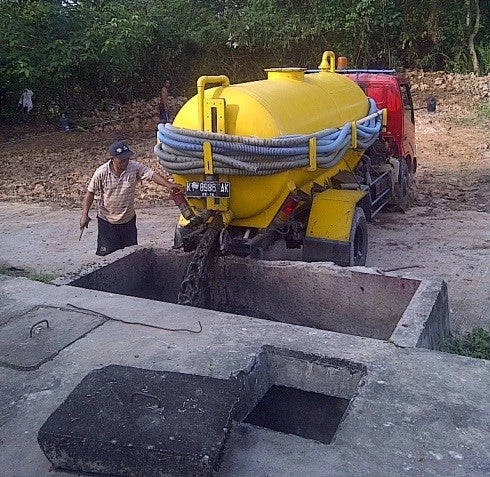
desludging services in Dar Es Salaam, Tanzania.
Photo credit: Kathy Eales / World Bank
Our last blog outlined the neglect of Fecal Sludge Management (FSM) and presented new tools for diagnosing FSM challenges and pointing the way to solutions.
In this blog, we’ll share some lessons learned from the city-specific case studies and analysis to highlight key areas which need to be addressed if the non-networked sanitation services on which so many citizens rely are to be effectively managed.
Lesson 1: Fecal sludge management must be included in national policy and legislation
On-site sanitation is often the only sanitation option for poor households, and may account for the majority of all sanitation, in many middle income and poor countries. However, the construction and servicing of on-site facilities is typically left to the unregulated informal sector. There can even be legal barriers to developing on-site sanitation, although integrated urban water management may identify the provision of clean piped water, with systematic FSM, as a cheaper, more effective solution than city-wide sewerage access. The formal recognition and regulation of on-site sanitation and FSM is therefore critical.National policy and legislation recognizing FSM as an essential part of urban sanitation is necessary to include FSM in planning and budgeting processes. When this is coupled with funding windows and reporting mechanisms, as in Malaysia (and being gradually applied in Philippines, India and Indonesia, amongst others) it can play an important part in achieving effective services at scale.
Lesson 2: City-level planning is fundamental
Cities vary widely, even within a country or province, so a systematic assessment of city sanitation is essential. The sanitation planning process within each city must be comprehensive , inclusive of the poorest communities and gender sensitive, and demonstrate where and how the sanitation service chain is failing. Failure to do this will leave the city wide open to public health risks. For example, in Lima, although only 7% of the population overall uses on-site systems, 7% represents almost a million people living in peripheral, unplanned settlements, where 90% of the population uses unhygienic latrines, constituting a public health hazard which is transported daily into the homes, shops, offices and factories of the city.Based on a systematic assessment, service targets, city-wide investment plans and viable service funding arrangements for FSM should be included alongside sewerage in city development plans. To maximize public health benefits, public resources should be distributed equitably between networked and non-networked sanitation, which may mean for FSM, subsidizing different parts of the sanitation service chain than for sewerage, where the focus is usually on infrastructure for conveyance (sewers) and treatment.
Lesson 3: Define local institutional, regulatory, legal and financial arrangements
There is no ‘one model fits all’, but the utility, together with the private sector,
may be best placed to manage FSM services where there is widespread piped water supply. Where local government has responsibility for FSM, the municipality may be a service provider, also providing capacity to deal with public emergencies and sending price signals to the market through a limited service for paying customers.
Clear local byelaws or ordinances which oblige both households and service providers to play their part in delivering effective sanitation are a necessary underpinning of the institutional responsibilities for FSM. Regulations need not be complex to start with, especially when transitioning from informal services. As seen in Mozambique and Indonesia, increased recognition and formality can result in emptiers feeling less marginalized and stigmatized
To ensure that services are being provided effectively, FSM must be monitored end-to-end , with the key outcome being that people do not and cannot interact with fecal sludge. Because this is hard to measure, a useful proxy indicator is the proportion of fecal sludge discharged to a safe treatment or disposal facility.
Lesson 4: Successful fecal sludge management depends on partnerships

Photo credit: World Bank
Emptying services are provided mainly by small private and informal enterprises. To ensure hygienic and affordable services, technical and entrepreneurial training, access to capital, and development of an effective regulatory regime is necessary.
Lesson 5: Plan for incremental change
Cities are growing fast, with new informal opening up and older areas densifying or being redeveloped. There will thus always be a mix of settlement types, each with appropriate sanitation options, and changing over time. The responsible authorities need continuously identify and plan the type and location of interventions to optimize public health and environmental outcomes. This will mean an on-going program of investment in non-networked, decentralized and fully networked sanitation on a neighborhood-by-neighborhood basis.Related links:



Join the Conversation